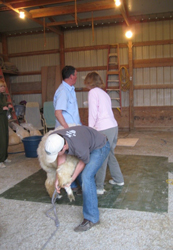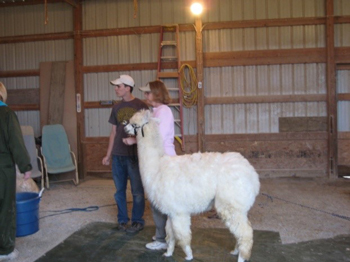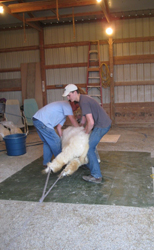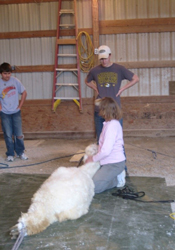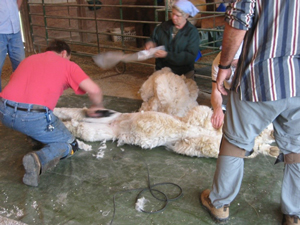Shearing Alpacas
Heartfelt products begin with an alpaca like Cindy Lou Who, our mascot. Sometime in the spring–usually April or May–we'll shear our herds. Diane and Linda do their own shearing a few animals at a time. Mary hires a professional shearer who shears in the US during the New Zealand winter off-season.
Friends and relatives converge at Curly Eye, and everyone gets a job. Mary halters the alpaca and leads it to the shearing station.
Two of the guys slide a rope hobble onto each of the alpaca's ankles and gently lower the animal down onto a tarp on the floor of the barn as a third and fourth person pull the rope pulley systems in front of and behind the animal. The ropes stretch the animal's legs out to prevent any movement. This protects the animal from being inadvertently cut by the shears.
Meanwhile, another person settles on the tarp to hold the animal's head. This seems to help calm the animal and also keeps the animal from head and neck movements that could result in cuts.
The shearer does the prime "blanket" fiber first–the area from the base of the neck to the tail over the back and rib cage. Yet another helper gathers this prime fiber into a big trash bag labeled with the animal's name. Then the belly, legs, neck, and head are shorn, and the fiber, which tends to be dirtier and coarser than the blanket fiber, is gathered into another big trash bag.
All this happens in about five to seven minutes. It may sound as though this is all a harried rush, but it isn't at all. It's more like a dance, where things keep moving, and every movement has its place, but no one is rushed.
Once all the fiber is sheared, the animal is released and led back to its stall, prepared for another mid-Missouri summer. While shearing day involves the stress of the noisy shears and strangers in the barn, there is often a fair amount of happy pronking in the pasture after the shearing is finished. It's clear that the alpacas are glad to be rid of the weight and heat of their winter fleeces.
Shearing is the alpaca owner's harvest time, but it's also a health requirement for the alpacas. Alpaca fleece is warmer than wool, and the typical alpaca has anywhere from 5 to 12 pounds of fleece after a year's growth. Without the spring shearing, our alpacas could easily succumb to heat stress and die in the heat and humidity of Midwestern summers. Even shorn, they will need fans running throughout the summer months.
Their owners are too tired to do any pronking, but there is usually a fine meal and lots of good company after the shearing is done. . . . We'll think about sorting all those bags of fiber another day!

